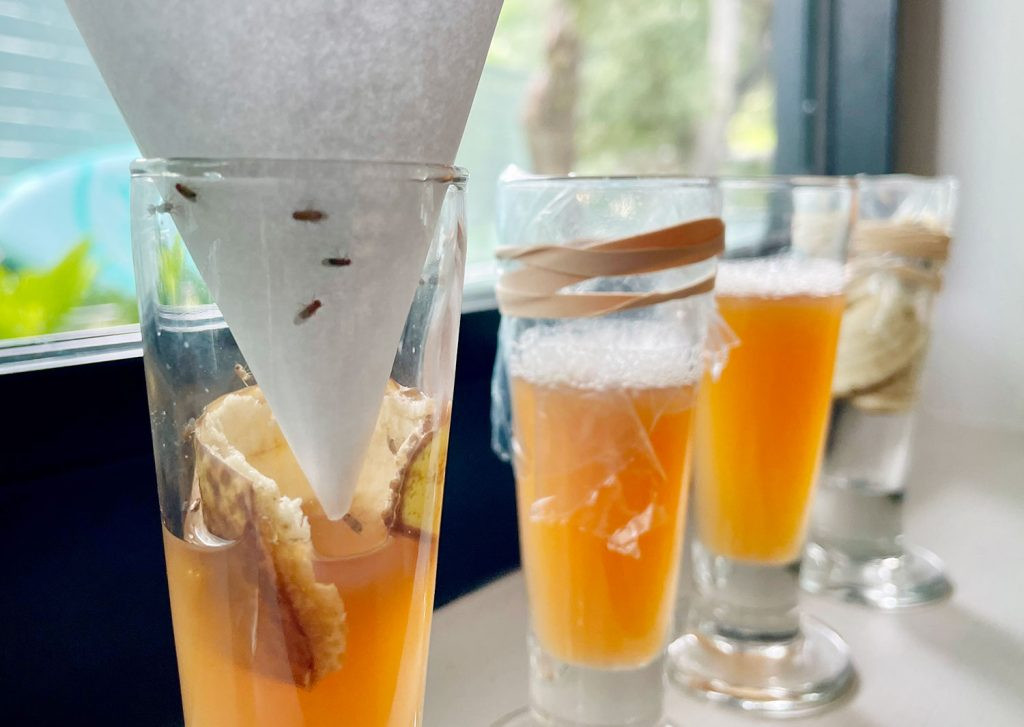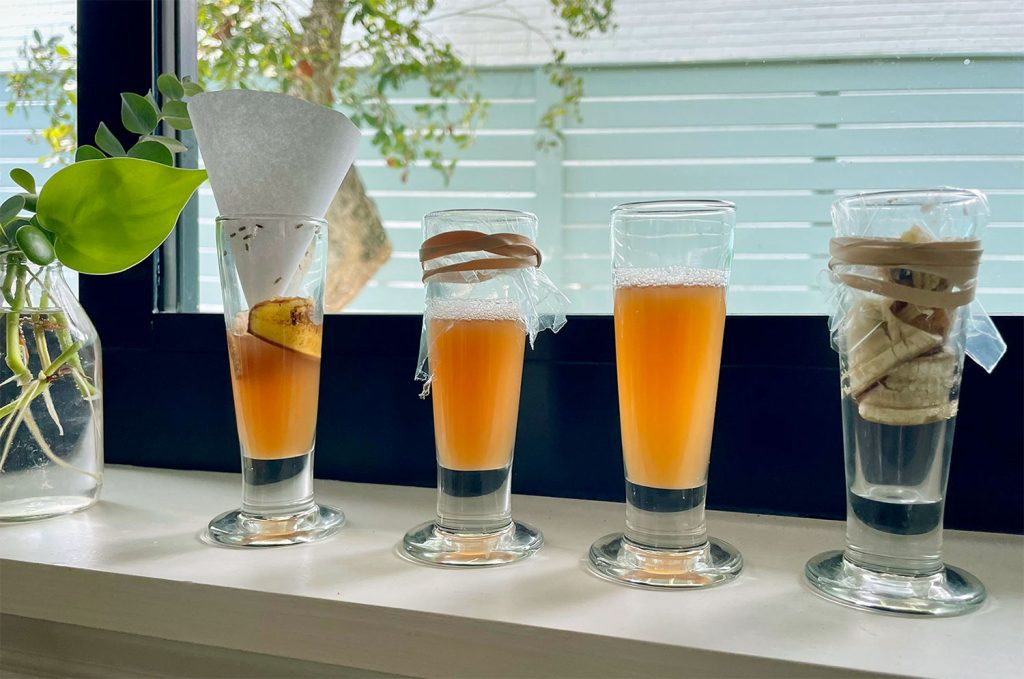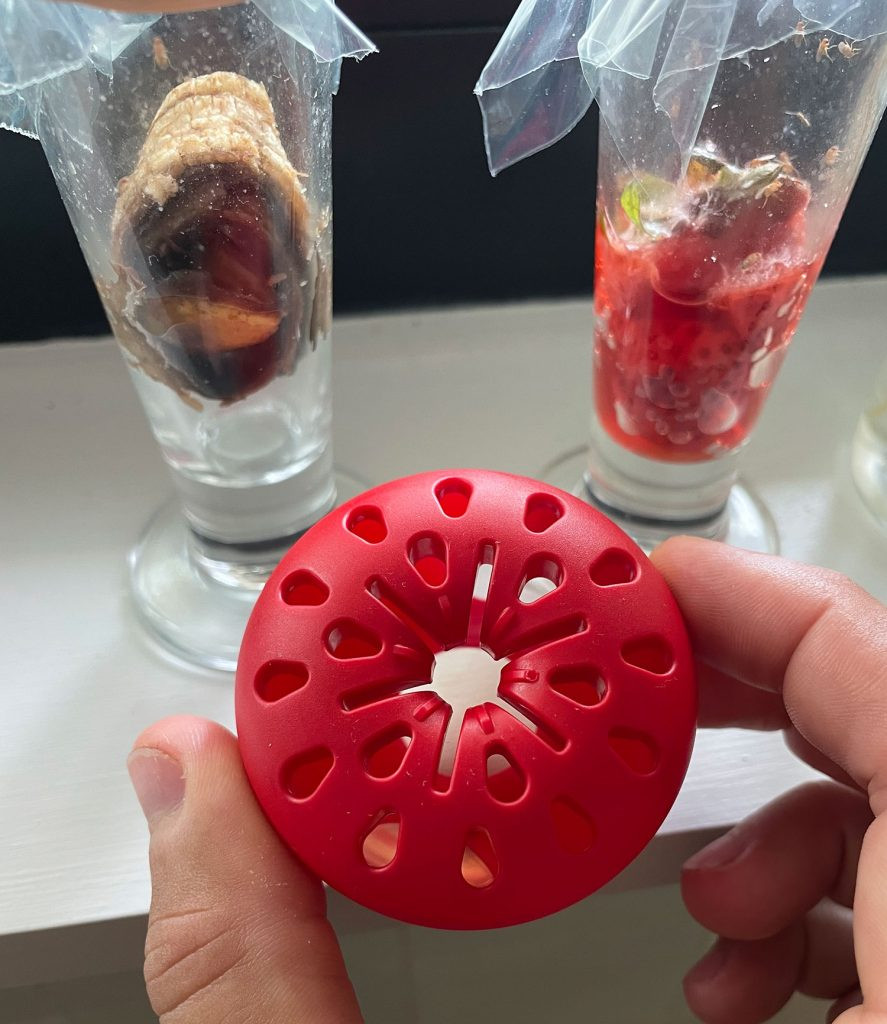What Can You Use To Get Rid Of Fruit Flies? You may be wondering about the tiny insects buzzing around your ripe produce. At flyermedia.net, we understand your frustration and offer simple, effective solutions to eliminate these common household pests. These tips not only help you banish the bugs, but also teach you about comprehensive insights into insect control, sanitation practices, and effective home maintenance, ensuring a bug-free and pleasant living environment.
1. What Exactly Are Fruit Flies?
Fruit flies are small, irritating insects that belong to the Drosophilidae family. These tiny pests are drawn to overripe or fermenting fruits and vegetables, as well as sugary liquids. Identifying fruit flies is the first step in eradicating them, they are roughly 1/8 inch long, often brown or tan, and have characteristic red eyes. These pests are often found near fruit bowls, garbage cans, and other locations where food is available.
 Fruit Flies Trapped In DIY Funnel Trap Method
Fruit Flies Trapped In DIY Funnel Trap Method
1.1 How Do Fruit Flies Differ from Other Small Flies?
It’s easy to confuse fruit flies with other small flies that may appear in your home. Here’s a quick guide to help you distinguish them:
- Fruit Flies: Small, tan or brownish, and found near ripe fruit.
- Drain Flies: Fuzzy and moth-like, typically found near drains.
- Fungus Gnats: Similar to small mosquitoes and found near houseplants.
Being able to tell the difference will allow you to tailor your control strategy and increase its effectiveness.
1.2 Why Are Fruit Flies So Common?
Fruit flies are common because of their fast reproductive cycle and attraction to decaying organic matter. A female fruit fly can lay hundreds of eggs near fermenting food sources, and these eggs can hatch in as little as 24 hours. This rapid reproduction rate means that a small issue can quickly escalate into a major infestation.
2. What Are the Best DIY Fruit Fly Traps?
Many effective DIY solutions can help you eliminate fruit flies without using harmful chemicals. These traps are simple to assemble and use common household ingredients, making them a cost-effective way to control these pests.
 4 DIY Fruit Fly Traps Tested On Windowsill
4 DIY Fruit Fly Traps Tested On Windowsill
2.1 How to Make a Funnel Trap for Fruit Flies
A funnel trap is a simple and effective way to catch fruit flies. It takes advantage of their attraction to sweet smells while preventing them from escaping.
Supplies:
- Small jar or container
- Apple cider vinegar
- Paper or cardstock
- Tape
- Scissors
Instructions:
- Pour a small amount of apple cider vinegar into the jar.
- Roll the paper into a cone shape with a small opening at the bottom and tape it together.
- Place the funnel into the jar, ensuring the tip doesn’t touch the vinegar.
- The fruit flies will enter the funnel but struggle to get out.
2.2 Creating a Plastic Wrap Trap
This method involves trapping fruit flies using plastic wrap and a tempting bait. It’s easy to set up and can quickly reduce the fruit fly population.
Supplies:
- Jar or container
- Apple cider vinegar
- Plastic wrap
- Rubber band
- Toothpick
Instructions:
- Pour apple cider vinegar into the jar.
- Cover the jar tightly with plastic wrap and secure it with a rubber band.
- Poke a few small holes in the plastic wrap using a toothpick.
- The flies will enter through the holes but have difficulty escaping.
2.3 How Effective Is a Dish Soap Trap?
Adding dish soap to a bait solution disrupts the surface tension of the liquid, causing fruit flies to drown when they land on it. This is a straightforward and effective method for killing fruit flies.
Supplies:
- Small bowl
- Apple cider vinegar
- Dish soap
Instructions:
- Fill the bowl with apple cider vinegar.
- Add a few drops of dish soap and gently mix.
- The fruit flies will be attracted to the vinegar, land on the surface, and drown.
2.4 Using Rotting Fruit as Bait
Fruit flies are naturally attracted to rotting fruit. You may use this to your advantage by preparing a trap that contains overripe fruit.
Supplies:
- Jar or container
- Overripe fruit (banana peel, apple slice)
- Plastic wrap or paper funnel
Instructions:
- Place the overripe fruit in the jar.
- Cover the jar with plastic wrap and poke small holes, or use a paper funnel.
- The fruit flies will be drawn to the rotting fruit and get trapped inside.
3. Which Bait Works Best for Fruit Fly Traps?
The effectiveness of a fruit fly trap largely depends on the bait used. Different baits attract fruit flies to varying degrees, and selecting the right one can significantly improve your trap’s success.
 Fruit Fly Entering Plastic Wrap On DIY Trap
Fruit Fly Entering Plastic Wrap On DIY Trap
3.1 The Allure of Apple Cider Vinegar
Apple cider vinegar (ACV) is a popular and effective bait for fruit flies. The fermentation smell attracts them, making it a reliable option for DIY traps.
According to a study at Clemson University, apple cider vinegar is effective due to its acetic acid content, which mimics the scent of fermenting fruit that fruit flies find irresistible.
3.2 How Does Fruit Compare as Bait?
Rotting fruit can be more attractive to fruit flies than apple cider vinegar. The strong, natural smell of decaying fruit draws them in quickly, making it an excellent alternative.
3.3 Testing Different Fruit Baits: Banana vs. Apple vs. Strawberry
Different types of fruit can attract fruit flies differently. Testing various fruits can help you determine which one works best in your trap.
Experiment:
- Place banana peel, apple slices, and strawberry in separate traps.
- Monitor which trap catches the most fruit flies.
In a test conducted by Young House Love, strawberries proved to be the most effective, followed by bananas, while apples were the least effective.
4. Are There Effective Store-Bought Fruit Fly Traps?
While DIY traps are often effective, store-bought fruit fly traps provide a convenient alternative. These traps are designed to be discreet and effective, offering a hassle-free solution for managing fruit fly infestations.
 Terro Fruit Fly Apple Trap With No Fruit Flies In It
Terro Fruit Fly Apple Trap With No Fruit Flies In It
4.1 Reviewing Popular Store-Bought Traps
Several store-bought traps are available, each with its own design and attractant. Some popular options include:
- Terro Fruit Fly Trap: Uses a non-toxic liquid attractant.
- RESCUE! Fruit Fly Trap: Features a long-lasting lure and a discreet design.
- Dr. Killigan’s Premium Fruit Fly Traps: Stylish and effective with a powerful attractant.
4.2 DIY vs. Store-Bought: Which Is More Effective?
The choice between DIY and store-bought traps depends on your preferences and the severity of the infestation. DIY traps are cost-effective and use readily available materials, while store-bought traps offer convenience and a discreet design.
According to tests conducted by Young House Love, homemade traps with strawberry bait performed better than store-bought traps initially. However, store-bought traps were effective over a longer period.
5. What Steps Can You Take To Prevent Fruit Flies?
Preventing fruit flies from invading your home is the best strategy. By following good hygiene practices and eliminating potential breeding sites, you can reduce the chance of an infestation.
5.1 Maintaining a Clean Kitchen
Regularly cleaning kitchen surfaces is crucial for preventing fruit flies. Wipe down counters, stovetops, and tables to remove food residue and spills.
5.2 Proper Waste Management
Take out the trash regularly to prevent food scraps from becoming breeding grounds for fruit flies. Use trash cans with tight-fitting lids to contain odors and prevent access.
5.3 Handling Overripe Fruit
Monitor your fruit bowl regularly and dispose of overripe or rotting fruit immediately. Store fruit in the refrigerator to slow down the ripening process and deter fruit flies.
5.4 Washing Produce Immediately
Washing fruits and vegetables as soon as you bring them home can eliminate any eggs or larvae that may be present. This simple step can prevent fruit flies from hatching in your kitchen.
5.5 The Importance of Drain Maintenance
Clean your sink drains regularly to remove food scraps and organic matter that can attract fruit flies. Use a drain cleaner or pour boiling water down the drain to eliminate buildup.
6. What Role Does Sanitation Play in Fruit Fly Control?
Sanitation is key to controlling and preventing fruit flies. Eliminating food sources and breeding sites deprives fruit flies of what they need to survive and reproduce, thereby reducing their numbers.
6.1 Identifying and Eliminating Breeding Sites
Fruit flies lay their eggs near fermenting substances. Common breeding sites include:
- Overripe fruit and vegetables
- Spilled juice and sugary drinks
- Garbage cans
- Dirty drains
- Uncleaned recycling bins
Regularly inspect and clean these areas to eliminate potential breeding sites.
6.2 Best Practices for Cleaning Kitchens and Pantries
Effective cleaning practices in kitchens and pantries include:
- Wiping down surfaces with disinfectant cleaners.
- Storing food in airtight containers.
- Regularly cleaning out refrigerators and pantries to remove spoiled food.
- Sweeping and mopping floors to remove food particles.
6.3 What is the Impact of Proper Food Storage?
Proper food storage is essential for preventing fruit fly infestations. Store fruits and vegetables in the refrigerator whenever possible, and use airtight containers for dry goods like flour and sugar.
7. What Attracts Fruit Flies to Homes in the First Place?
Understanding what attracts fruit flies to your home can help you take proactive steps to prevent infestations. Fruit flies are drawn to the scent of fermenting sugars and decaying organic matter.
7.1 The Role of Fermenting Foods
Fermenting foods, such as overripe fruit, beer, and wine, emit odors that attract fruit flies. These insects use their keen sense of smell to locate these food sources.
7.2 How Does Improper Waste Disposal Contribute?
Improper waste disposal creates ideal breeding conditions for fruit flies. Food scraps left in garbage cans or compost bins provide a food source for larvae.
7.3 What is the Influence of Environmental Factors?
Environmental factors such as temperature and humidity can influence fruit fly activity. Fruit flies thrive in warm, humid conditions, which are common in kitchens and pantries during the summer months.
8. What is the Life Cycle of a Fruit Fly and How Does It Impact Control Measures?
Understanding the life cycle of a fruit fly is essential for effective control. The life cycle consists of four stages: egg, larva, pupa, and adult.
8.1 What Are the Stages of the Fruit Fly Life Cycle?
- Egg: Female fruit flies lay their eggs near fermenting food sources.
- Larva: The eggs hatch into larvae, which feed on the surrounding organic matter.
- Pupa: The larvae develop into pupae, which transform into adult flies.
- Adult: Adult fruit flies emerge from the pupae and begin reproducing.
8.2 How Long Does It Take for a Fruit Fly to Develop?
The entire life cycle of a fruit fly can be completed in as little as 8 to 10 days under ideal conditions. This rapid development rate allows fruit fly populations to increase quickly.
8.3 What is the Impact of Understanding the Life Cycle on Control Strategies?
Knowing the fruit fly life cycle helps target control measures effectively. For example, eliminating breeding sites prevents larvae from developing, while traps target adult flies.
9. What are Some Natural Remedies for Eliminating Fruit Flies?
In addition to DIY traps, several natural remedies can help eliminate fruit flies. These remedies are safe, environmentally friendly, and effective for controlling fruit fly populations.
9.1 Using Essential Oils to Repel Fruit Flies
Certain essential oils, such as lavender, peppermint, and eucalyptus, have insect-repellent properties. Diffusing these oils in your kitchen can help deter fruit flies.
9.2 How Does Diatomaceous Earth Work?
Diatomaceous earth (DE) is a natural powder made from fossilized diatoms. It is effective for killing insects by dehydrating them. Sprinkle DE around potential breeding sites to control fruit fly larvae.
9.3 What is the Role of Herbs and Spices?
Certain herbs and spices, such as cloves, bay leaves, and basil, can repel fruit flies. Place these herbs and spices near fruit bowls and other areas where fruit flies are common.
10. What are the Health and Economic Impacts of Fruit Flies?
While fruit flies are mainly a nuisance, they can have health and economic impacts. Understanding these impacts can highlight the importance of effective fruit fly control.
10.1 Are Fruit Flies Harmful to Human Health?
Fruit flies themselves are not harmful to humans, as they do not bite or transmit diseases. However, they can contaminate food with bacteria and other pathogens.
10.2 What is the Economic Impact of Fruit Flies in the Food Industry?
In the food industry, fruit flies can cause significant economic losses by damaging fruit crops and contaminating processed food products. Effective pest management is essential for minimizing these losses.
10.3 How Does Fruit Fly Infestation Affect Homeowners?
For homeowners, fruit fly infestations can lead to food spoilage, increased cleaning efforts, and the cost of pest control products. Preventing infestations can save time and money.
At flyermedia.net, we understand the importance of maintaining a clean and pest-free environment. Our comprehensive resources provide you with the knowledge and tools you need to effectively manage fruit flies and other household pests. From DIY solutions to professional advice, we are here to help you create a comfortable and healthy home.
Ready to say goodbye to fruit flies for good? Visit flyermedia.net for more tips, tricks, and expert advice on pest control and home maintenance. Let us help you reclaim your kitchen and enjoy a fruit fly-free living space today!
FAQ: What Can You Use to Get Rid of Fruit Flies
-
What attracts fruit flies to my home?
- Fruit flies are attracted to fermenting substances, such as overripe fruit, spilled juice, and sugary drinks. Proper sanitation and food storage can help reduce their attraction.
-
How quickly can fruit flies reproduce?
- Fruit flies can complete their life cycle in as little as 8 to 10 days, allowing populations to increase rapidly under ideal conditions.
-
Is apple cider vinegar an effective bait for fruit fly traps?
- Yes, apple cider vinegar is an effective bait due to its acetic acid content, which mimics the scent of fermenting fruit that fruit flies find irresistible.
-
What are some DIY methods for getting rid of fruit flies?
- DIY methods include funnel traps, plastic wrap traps, dish soap traps, and using rotting fruit as bait.
-
Can essential oils help repel fruit flies?
- Yes, certain essential oils like lavender, peppermint, and eucalyptus have insect-repellent properties and can help deter fruit flies.
-
Are store-bought fruit fly traps effective?
- Store-bought fruit fly traps can be effective, offering convenience and a discreet design. However, homemade traps with the right bait can sometimes be more effective initially.
-
What role does sanitation play in controlling fruit flies?
- Sanitation is key, as eliminating food sources and breeding sites deprives fruit flies of what they need to survive and reproduce, thereby reducing their numbers.
-
How can I prevent fruit flies from infesting my kitchen?
- Preventative measures include maintaining a clean kitchen, proper waste management, handling overripe fruit, washing produce immediately, and maintaining your sink drains.
-
Are fruit flies harmful to human health?
- Fruit flies themselves are not harmful to humans, but they can contaminate food with bacteria and other pathogens.
-
What is the economic impact of fruit flies in the food industry?
- In the food industry, fruit flies can cause significant economic losses by damaging fruit crops and contaminating processed food products.
